What is blonde coffee and why is everyone suddenly talking about it? This light-roasted specialty has been taking the coffee industry by storm, offering a unique flavor profile that might change how you think about your morning brew.
Blonde coffee refers to beans that undergo a shorter roasting process than traditional medium or dark roasts. The result is a lighter-colored bean that preserves more of the coffee’s natural flavors and often delivers higher caffeine content. If you’ve noticed this golden-hued option appearing on coffee shop menus lately, you’re witnessing a growing trend that celebrates coffee’s brighter, more acidic characteristics rather than the robust, caramelized flavors of darker roasts.
What Is Blonde Coffee?
Blonde coffee refers to a light roast coffee that’s roasted for less time than medium or dark roasts. This shorter roasting process preserves more of the bean’s original characteristics, resulting in a lighter color and distinct flavor profile. Coffee beans undergo important transformations during roasting, with blonde roasts typically heated to temperatures between 355-400°F compared to dark roasts that reach 465-485°F.
The term “blonde” gained mainstream popularity when Starbucks introduced their Blonde Roast in 2012, though light roasts have existed in specialty coffee shops for much longer. These lighter roasts retain more of the natural flavors exact to the bean’s origin—fruity, floral, and citrus notes often shine through rather than being overshadowed by roasting flavors.
Caffeine content in blonde coffee is typically higher than in darker roasts because less caffeine burns off during the shorter roasting process. A standard 8-ounce cup of blonde coffee contains approximately 180mg of caffeine compared to 150mg in the same amount of dark roast.
The acidity level in blonde coffee is also more pronounced, creating a brighter, more vibrant taste experience. Many coffee enthusiasts appreciate blonde roasts for their complex flavor profiles that showcase the unique characteristics of different growing regions, such as the berry notes from Ethiopian beans or the chocolate undertones from Colombian varieties.
The Origin and History of Blonde Coffee
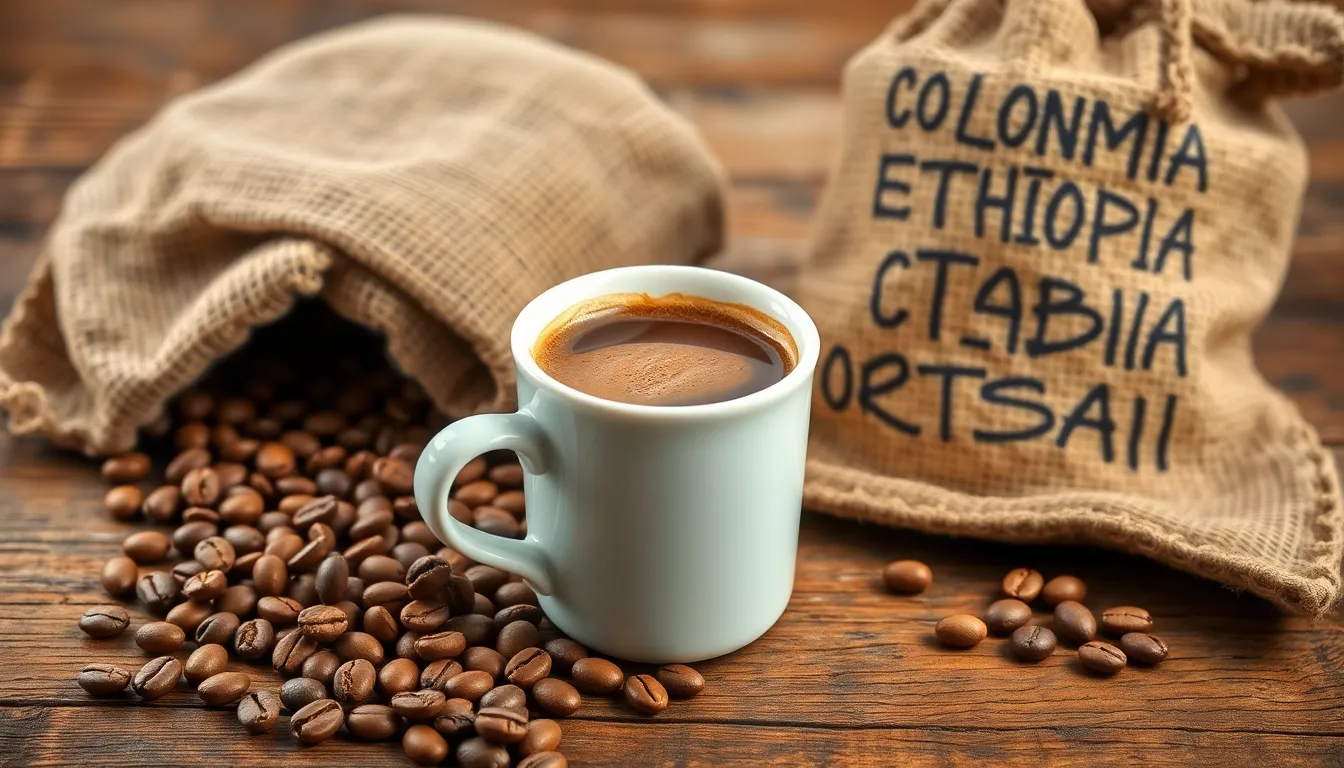
Blonde coffee’s history traces back to traditional light roasting techniques that have existed for generations in the coffee industry. Coffee beans for blonde roasts are heated for shorter periods, typically stopping just before or after the “first crack” occurs during the roasting process. This crucial moment happens when beans start to expand and crack open due to the heat releasing internal gases.
Light roasting methods predate the term “blonde roast” and were previously known by various names including “light city” and “cinnamon” roast. The “cinnamon” designation refers to the light brown color achieved during roasting, not the flavor profile of the coffee itself.
Marketing strategies from major coffee brands transformed how consumers perceive light roasts. Starbucks notably popularized the term “blonde roast” as part of their branding efforts, helping bring this lighter coffee style into mainstream awareness. Their 2012 introduction of the Blonde Roast significantly contributed to the rising popularity of lighter coffee options.
Geographically, blonde coffee showcases distinctive characteristics from exact growing regions. Colombian, Ethiopian, and Costa Rican beans frequently appear in blonde roasts because their natural fruity and acidic qualities remain intact through the gentle roasting process. These regional flavor profiles get preserved rather than masked by heavier roasting flavors.
The modern appeal of blonde coffee connects directly to its ability to highlight a bean’s origin story. Coffee enthusiasts increasingly appreciate tasting the authentic flavor notes that reflect the soil, climate, and cultivation practices of coffee-growing regions around the industry.
Blonde Roast vs. Other Coffee Roasts
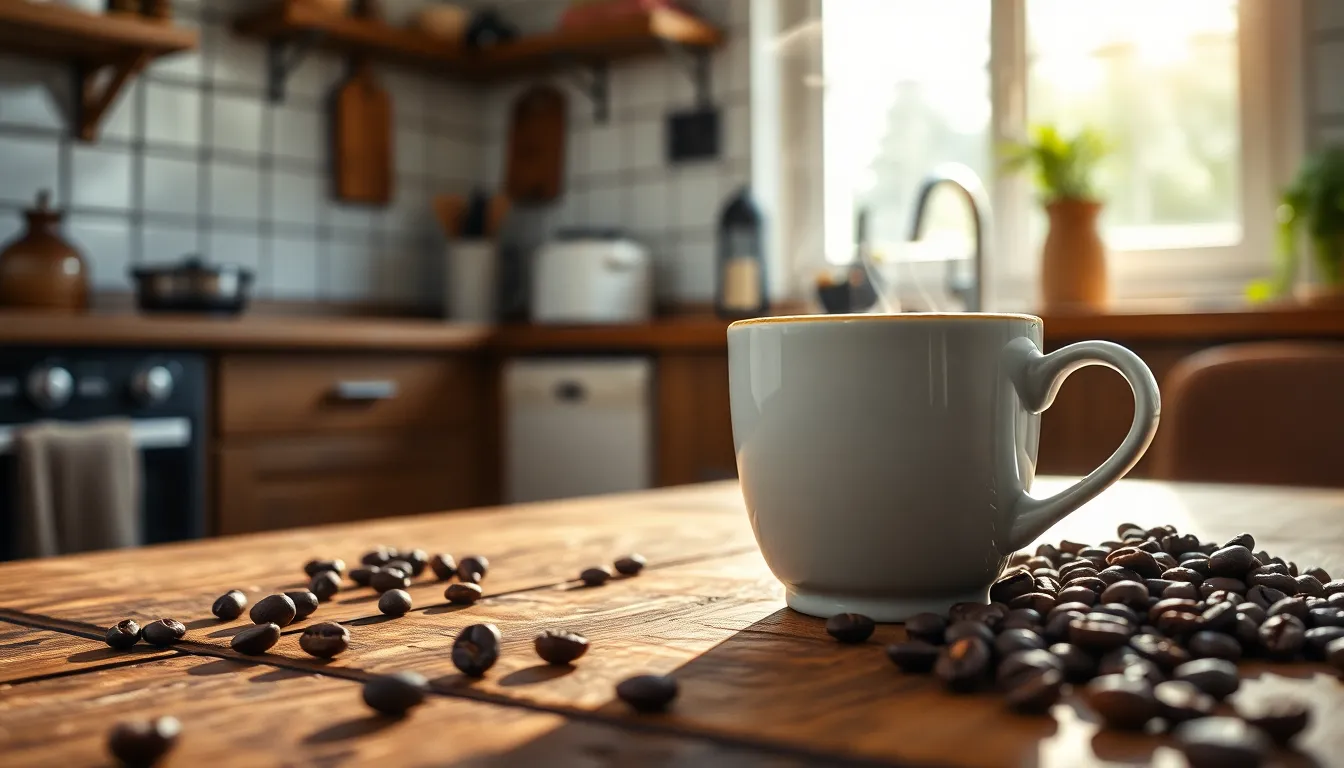
Blonde roast coffee stands apart from its darker counterparts in several important ways. Its unique characteristics emerge from exact roasting techniques that influence everything from color and flavor to caffeine content.
Light Roast Comparison
Blonde roast belongs to the light roast family, sharing space with varieties like “Light City” and “Cinnamon” roast. These light roasts preserve more of the coffee bean’s inherent qualities due to minimal roasting time, typically pulled from roasters just before or immediately after the first crack. The shorter roasting process retains the bean’s density and prevents oil development on the surface. Light roasts showcase bright, vibrant flavors with pronounced acidity, highlighting the bean’s origin characteristics. You’ll notice floral undertones, citrus notes (lemon, orange), and berry flavors (blueberry, strawberry) in properly brewed blonde coffees, making them perfect for coffee enthusiasts who appreciate complex flavor profiles from exact growing regions.
Medium and Dark Roast Differences
Medium roasts offer a balanced profile between light and dark varieties, featuring moderate caramelization and some oil development on the beans. These roasts create what many consider the “standard” coffee flavor found in commercial brands, with balanced acidity, body, and flavor notes. Dark roasts, by comparison, undergo extended roasting time, resulting in beans that appear dark brown to almost black with visible surface oils. The extended heat exposure creates prominent bitterness, lower acidity, and bold flavors featuring smoky, chocolate, or caramelized sugar notes. Caffeine content gradually decreases with roast time, making blonde roasts slightly higher in caffeine than their darker counterparts even though their milder taste. The intense flavor of dark roasts often creates the perception of higher caffeine content, though chemical analysis proves otherwise. Each roast level highlights different aspects of the coffee experience – blonde roasts emphasize origin-exact flavors, medium roasts balance bean characteristics with roasting flavors, and dark roasts showcase the roasting process itself.
How Blonde Coffee Is Made
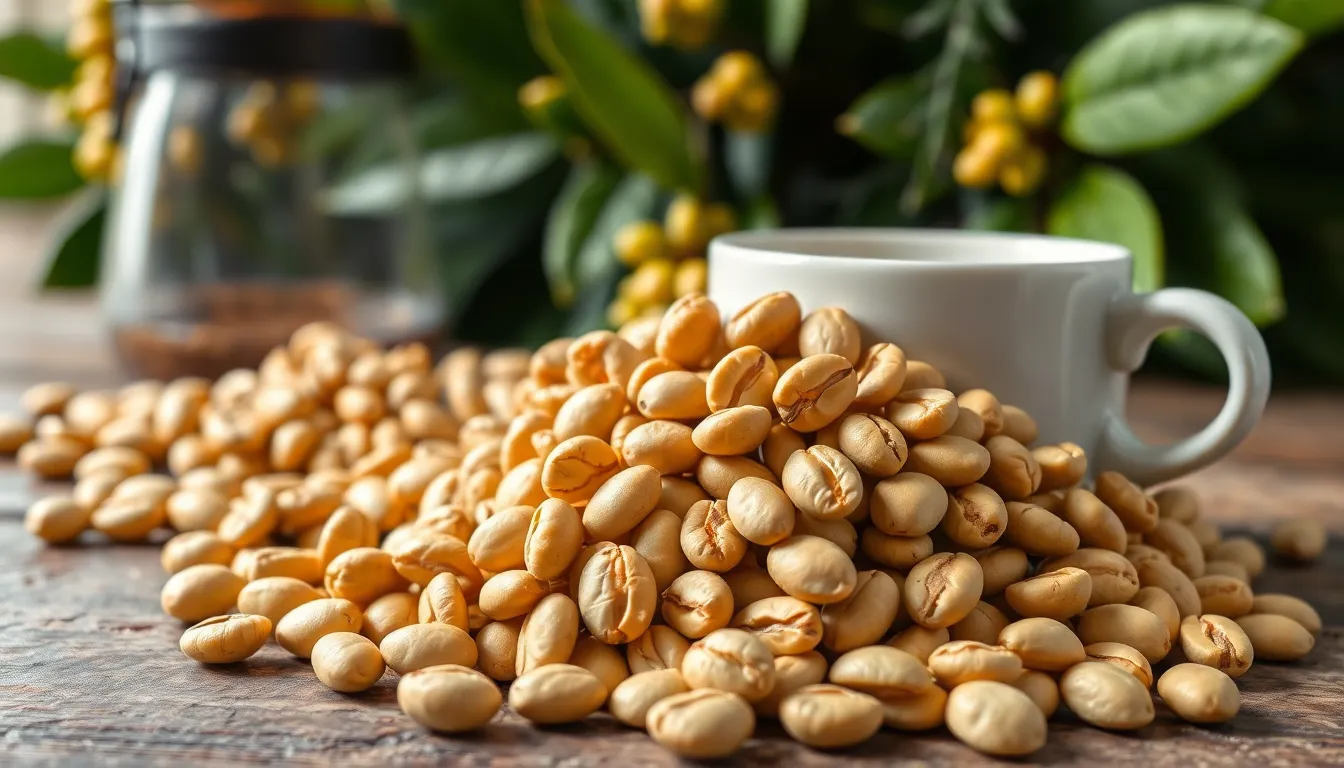
Blonde coffee production involves minimal roasting and caramelization, preserving more of the bean’s original characteristics and density. This light roasting approach maintains higher caffeine content while creating a distinctive golden color that gives blonde coffee its name.
The Roasting Process
The blonde roasting process requires precise temperature control between 355 and 400 degrees Fahrenheit, significantly lower than darker roasts. Roasters carefully monitor the beans and remove them just around the first crack phase—the moment when beans audibly crack due to expansion. This shorter roasting duration prevents the beans from darkening and preserves their natural acidity and fruity notes. The resulting coffee offers a mild, smooth profile with complex flavors including citrus notes like lemon and orange, berry undertones such as blueberry and strawberry, and a clean, refreshing aftertaste. Unlike darker roasts that develop more caramelized flavors, blonde coffee emphasizes brightness and clarity in each cup.
Bean Selection for Blonde Roasts
High-quality, dense beans form the foundation of exceptional blonde roasts, as they best highlight the delicate flavor profiles this roasting style aims to showcase. Beans from high-altitude regions particularly excel in blonde roasts, with Ethiopian and Kenyan varieties standing out for their complex sugars and bright, clean flavor characteristics. These premium beans are typically hand-picked to ensure only the finest specimens make it to the roaster. Wet-processing methods are commonly employed for blonde roast beans, as this technique enhances the clean, vibrant qualities that shine in lighter roasts. The careful selection process ensures that when you drink blonde coffee, you’re experiencing the authentic expression of the bean’s origin and natural flavor potential rather than flavors developed primarily through the roasting process.
Flavor Profile of Blonde Coffee
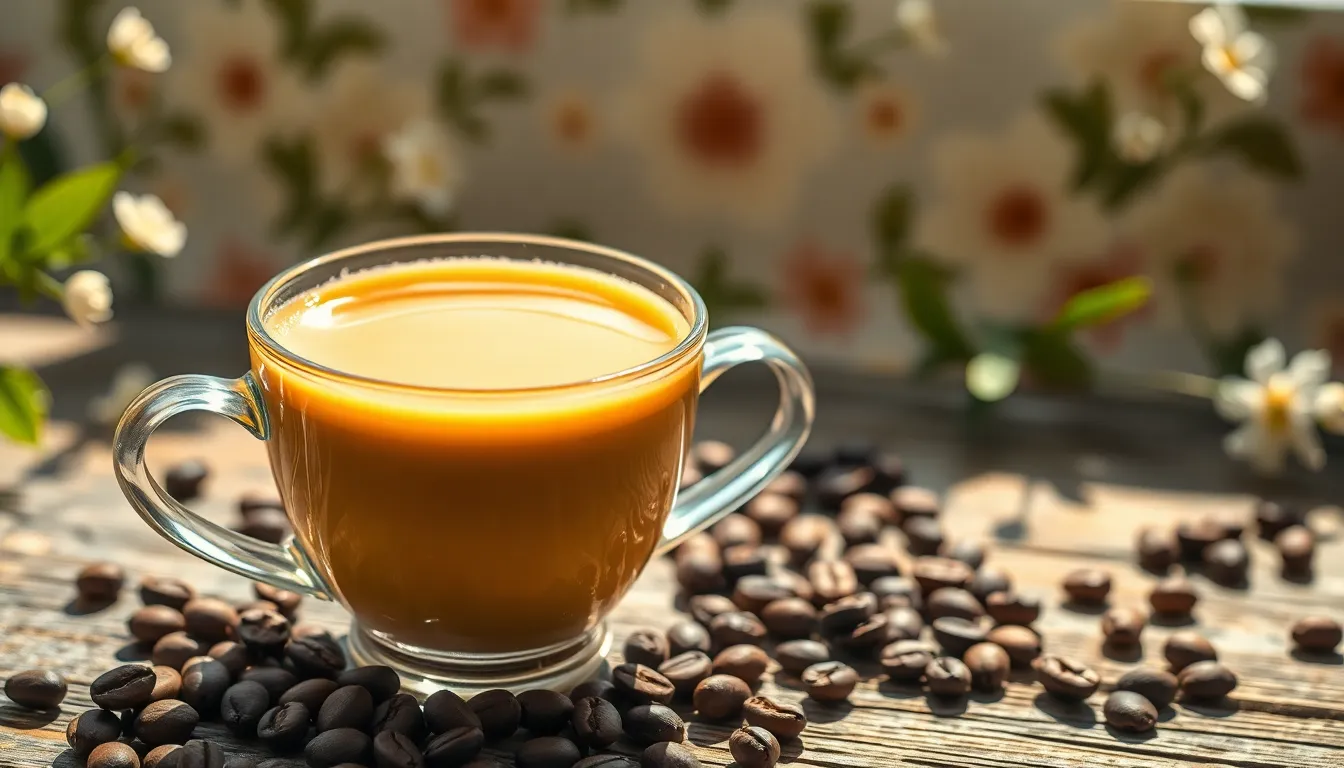
Blonde coffee delivers a distinct and delicate flavor experience that showcases the bean’s natural characteristics. The lighter roasting process preserves intrinsic flavors that darker roasts often mask, creating a unique taste profile that coffee enthusiasts increasingly appreciate.
Acidity and Brightness
Blonde roast coffee features noticeably higher acidity compared to medium or dark roasts, contributing to its signature bright, lively taste experience. This elevated acidity manifests as sharp, citrus-like notes reminiscent of lemon and orange, giving the coffee a refreshing quality that awakens your palate. The brightness cuts through with clarity, offering a clean mouthfeel that lets you experience the full spectrum of flavors without the heaviness common in darker roasts. High-quality blonde roasts from regions like Ethiopia and Kenya particularly showcase this brightness, as these high-altitude beans develop complex sugars that enhance their vibrant flavor profiles.
Subtle Taste Notes
Blonde coffee reveals delicate and nuanced flavor notes that dark roasting processes typically obscure. Fruity undertones like blueberry and strawberry often emerge alongside floral nuances that dance across your palate with surprising complexity. The body remains lighter and smoother than robust dark roasts, carrying these subtle flavors without overwhelming bitterness. Dense Arabica beans contribute significantly to this refined taste experience, particularly those sourced from premium growing regions known for producing beans with intricate flavor profiles. The minimal roasting preserves the coffee’s natural sweetness, allowing you to detect honey-like or caramel undertones that complement the bright acidity rather than competing with it.
Caffeine Content in Blonde Coffee
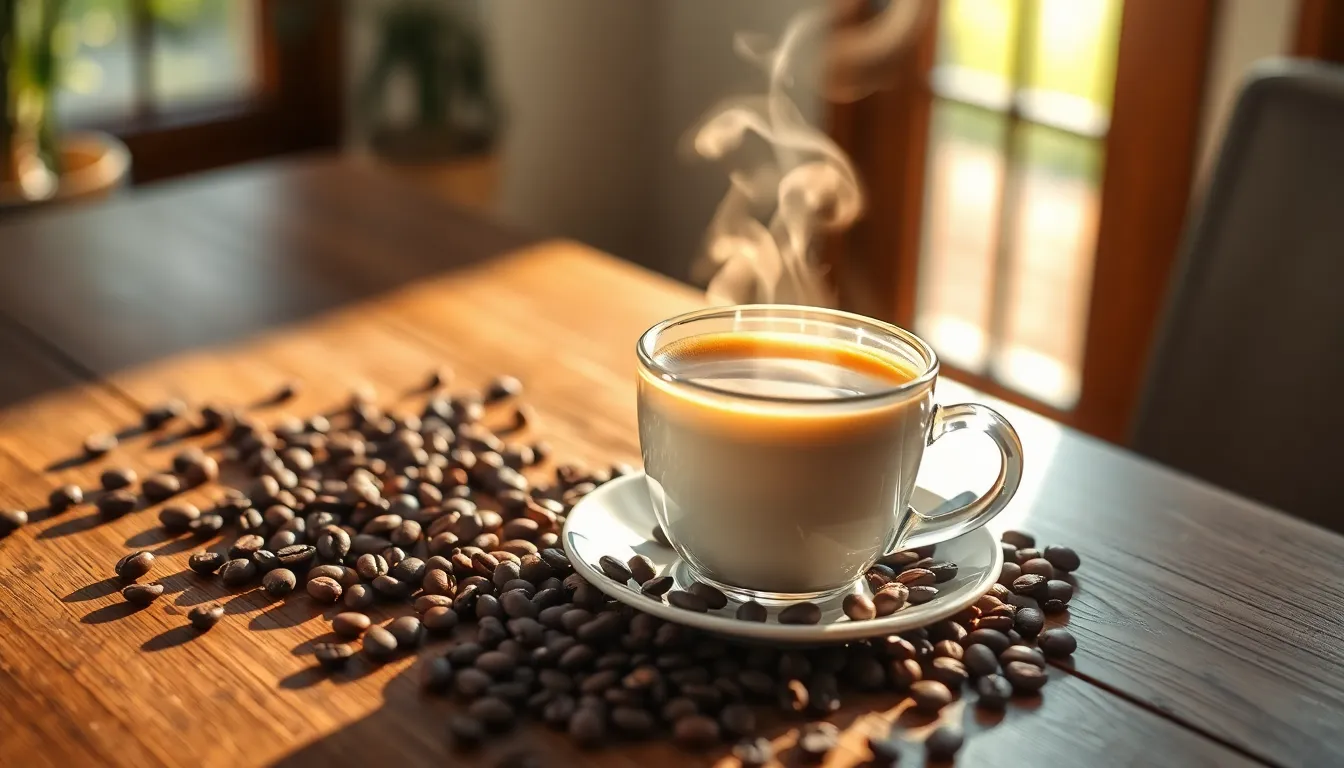
Blonde coffee contains more caffeine per cup than darker roasts, making it an excellent choice for those seeking an energy boost. The caffeine concentration in blonde roast is higher because these beans are denser, having undergone less expansion during the shorter roasting process. High-quality Arabica beans used in blonde roasts naturally pack more caffeine by volume when measured scoop for scoop.
Many coffee drinkers mistakenly believe darker roasts have more caffeine due to their stronger taste. This misconception stems from the intense flavor profile of dark roasts, which creates a perception of higher stimulant content. The reality shows that during extended roasting, some caffeine molecules break down, resulting in slightly lower caffeine levels in darker varieties.
Comparing the numbers reveals important differences – an 8-ounce cup of blonde coffee typically contains approximately 180mg of caffeine, while the same size of dark roast delivers around 150mg. Coffee shops occasionally adjust for this difference by using slightly smaller scoops for the denser blonde roast beans, though practices vary between establishments.
The caffeine retention in blonde coffee happens because these beans are pulled from roasters at temperatures between 355-400°F, preserving more of their natural compounds. Darker roasts reach temperatures of 465-485°F, which affects both flavor compounds and caffeine content. Your morning blonde coffee doesn’t just offer bright, fruity flavors – it delivers a more potent caffeine experience that might require fewer cups to achieve your desired alertness level.
Brewing Methods for Blonde Coffee
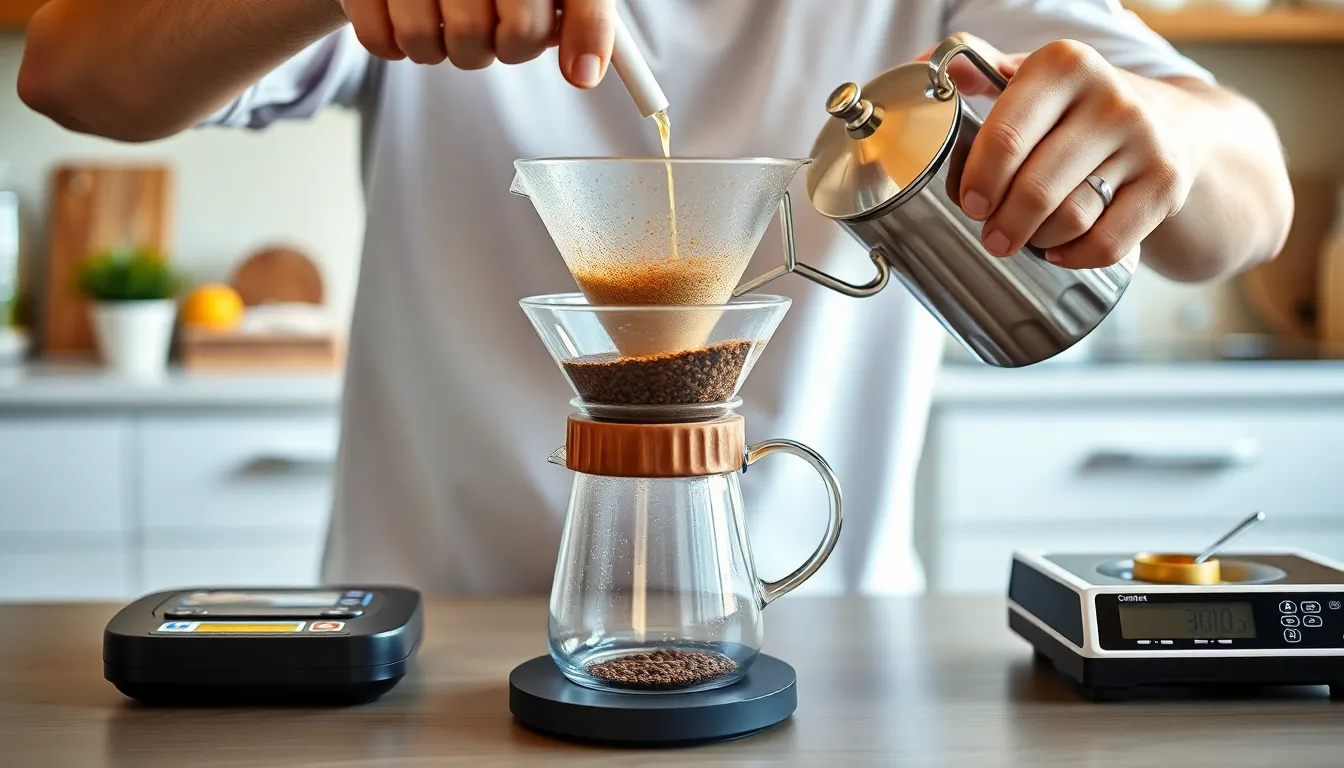
Blonde coffee’s delicate flavor profile requires exact brewing approaches to highlight its bright acidity and subtle notes. The right brewing method enhances the natural characteristics that make blonde roasts unique while preserving their nuanced flavor complexities.
Best Brewing Techniques
Pour-over methods excel at extracting blonde coffee’s vibrant flavors by providing precise control over water flow and brewing time. The V60 or Chemex brewers allow you to regulate extraction and emphasize the citrus and floral notes without overwhelming the palate. Aeropress brewing creates a clean cup that preserves blonde coffee’s bright acidity and fruity undertones through its quick extraction process. Drip coffee makers offer consistency for daily brewing, delivering a balanced cup that maintains the mild profile blonde coffee is known for. Cold brew works with blonde roasts but tends to mute some of their signature brightness—though many appreciate how it showcases the subtle sweetness. French press brewing is less commonly recommended for blonde coffee as its immersion method can produce a heavier body that might mask the delicate flavor nuances characteristic of light roasts.
Equipment Recommendations
Burr grinders provide the consistent, precise grind size essential for extracting blonde coffee’s complex flavors without introducing bitterness. Digital scales improve brewing accuracy by allowing you to measure coffee grounds and water precisely, maintaining the ideal ratio for optimal extraction. Temperature-controlled kettles maintain water at 195°F to 205°F (90°C to 96°C), slightly cooler than temperatures used for darker roasts to prevent over-extraction of blonde coffee’s delicate compounds. Pour-over equipment such as V60, Chemex, or Kalita Wave offers exceptional flow control that showcases blonde coffee’s clarity and brightness. Water filters remove impurities that might interfere with blonde coffee’s nuanced flavor profile, ensuring each cup delivers the clean, vibrant taste these light roasts are known for. Timers help you track extraction duration, preventing the under-extraction that can make blonde coffee taste sour or the over-extraction that introduces unwanted bitterness.
Health Benefits and Considerations
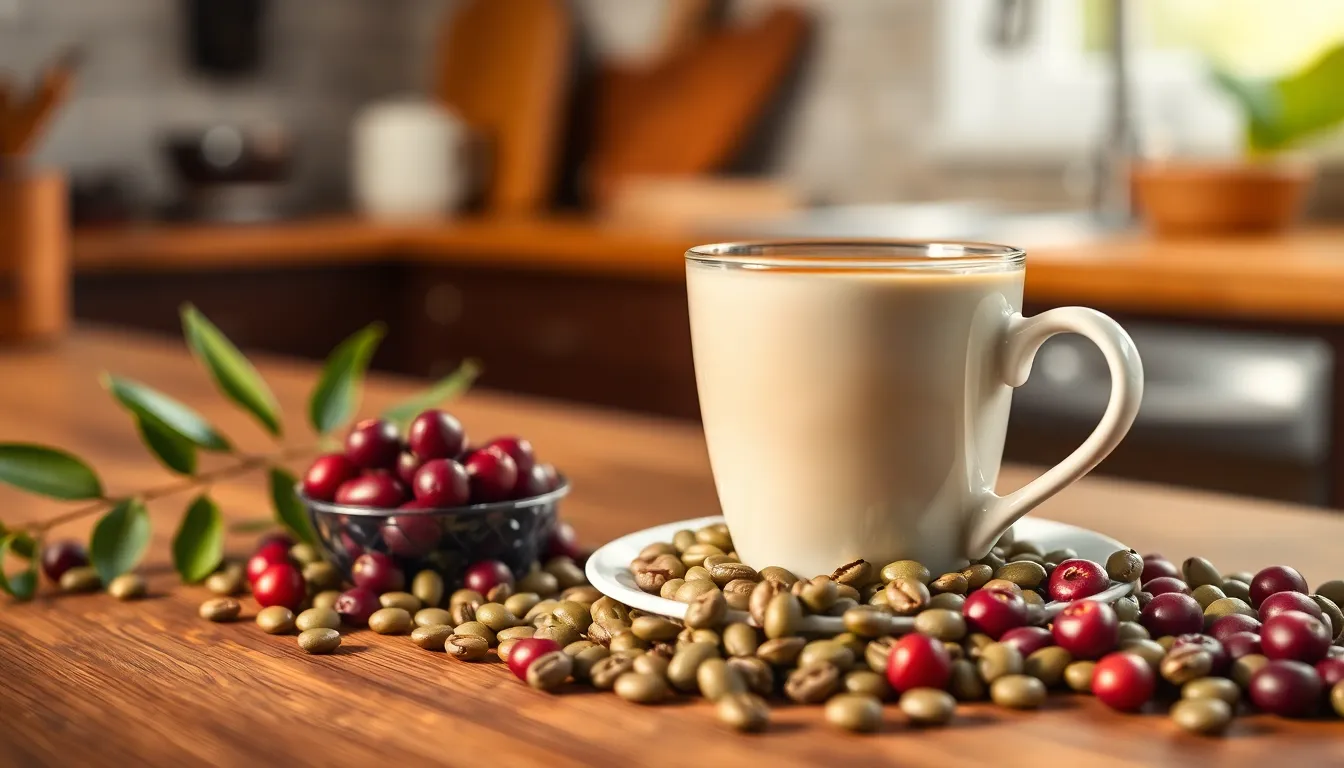
Blonde coffee offers several health advantages thanks to its unique roasting process. The light roasting method preserves more antioxidants compared to darker roasts, which lose some of these beneficial compounds during extended roasting periods. These antioxidants help combat free radicals in your body and support overall wellness.
The higher caffeine content in blonde coffee provides a more noticeable energy boost throughout your day. With approximately 180mg of caffeine per 8-ounce cup (compared to 150mg in dark roasts), blonde coffee enhances mental focus and alertness without requiring additional cups. This makes it an excellent choice for morning routines or afternoon pick-me-ups when you need sustained concentration.
Acidity levels in blonde coffee present both benefits and challenges for different drinkers. The bright, vibrant acidity contributes to the coffee’s distinctive flavor profile but may cause discomfort for individuals with sensitive stomachs or acid reflux conditions. If you experience digestive sensitivity, you might consider alternative brewing methods that reduce acidity or opt for a medium roast instead.
The clean taste profile of blonde coffee allows many coffee enthusiasts to enjoy it without additives. Drinking coffee without high-calorie creamers or sweeteners can support weight management goals while still delivering a satisfying beverage experience. The natural sweetness and complex flavor notes in blonde coffee make it enjoyable on its own.
High-quality blonde roasts from regions like Ethiopia and Kenya contain many micronutrients derived from the coffee’s growing conditions. These trace minerals and plant compounds contribute to the overall nutritional profile of your daily cup, offering subtle health benefits beyond the caffeine content.
Popular Blonde Coffee Brands
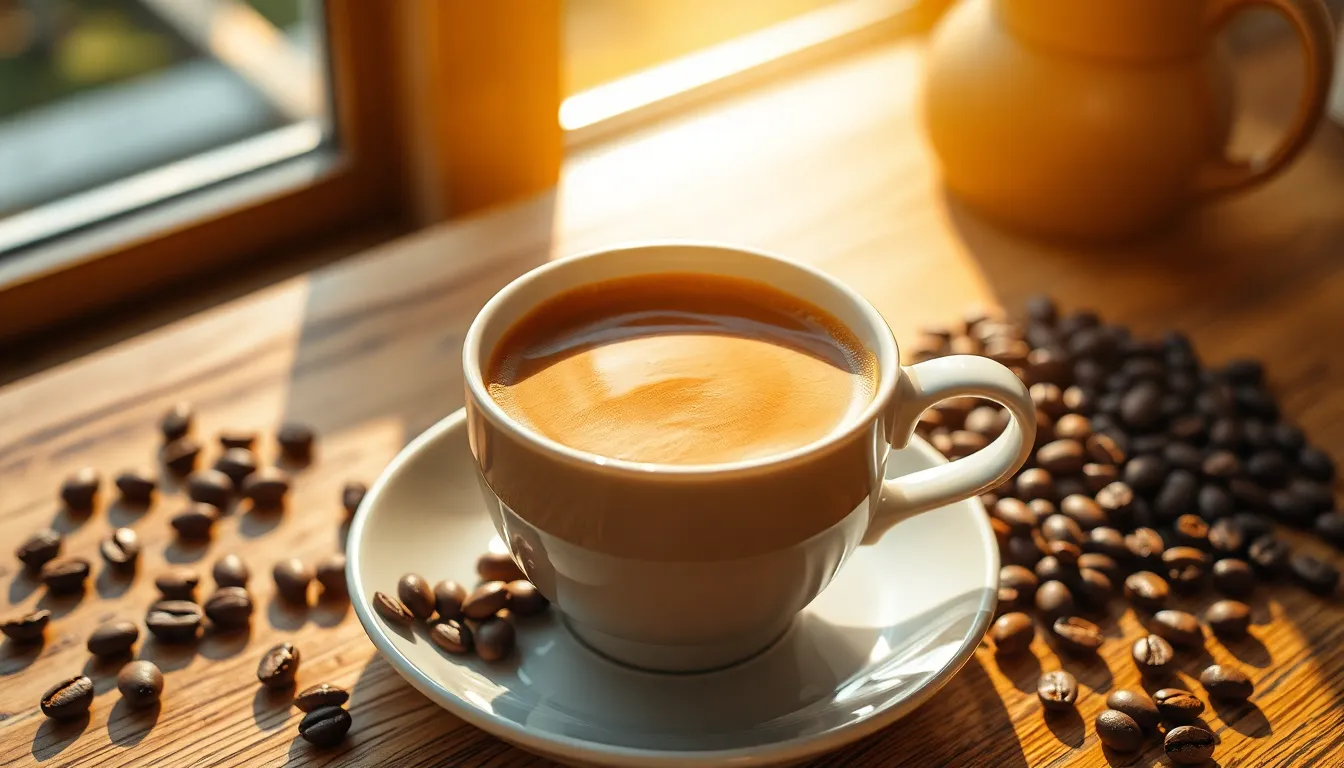
Starbucks Blonde Roast stands as the most recognizable blonde coffee on the market today. Introduced in 2012, this light-bodied option revolutionized how mainstream consumers perceive light roasts, offering a sweeter, smoother alternative to their traditional dark roasts. Coffee enthusiasts appreciate its mellow character and accessible flavor profile that maintains brightness without overwhelming bitterness.
Greater Goods delivers an exceptional single-origin blonde experience with their Fresh Perspective beans from Ethiopia. This light roast captivates with distinctive tasting notes of strawberry candy, creamed honey, and blueberry muffins—perfectly showcasing the classic brightness blonde roasts are known for. Each cup delivers a complex yet approachable flavor journey that highlights Ethiopia’s renowned coffee traditions.
PT’s Coffee has earned international recognition for their Flor de Sol blend, combining beans from Guatemala and Ethiopia. This carefully crafted blonde roast presents a sophisticated flavor profile featuring cocoa powder, raisin, and a bright lemon finish that lingers pleasantly. Coffee connoisseurs particularly enjoy how this blend balances the fruity characteristics typical of blonde roasts with subtle chocolate undertones.
Sisters Coffee from Oregon creates a memorable blonde experience with their High Desert Sunrise blend. Sourced from Latin American beans, this light roast delivers candied hazelnut flavors complemented by honey sweetness and citrus brightness. The balanced acidity makes this blend particularly versatile, working beautifully as both a morning cup and an afternoon refreshment.
These premium blonde coffee options reflect the growing consumer interest in lighter roasts that showcase the coffee’s origin characteristics rather than heavy roasting flavors. Each brand offers a unique interpretation of the blonde roast style while maintaining the hallmark qualities of higher acidity, complex flavor notes, and slightly elevated caffeine content compared to darker alternatives.
Conclusion
Blonde coffee stands as a testament to the evolving coffee culture that values bean origin and natural flavors. You’ll appreciate its bright acidity and complex flavor notes that showcase the true character of premium beans from regions like Ethiopia and Colombia.
With higher caffeine content than darker roasts and preserved antioxidants the light roasting process delivers both enjoyment and potential health benefits. Pour-over methods bring out the best in these delicate profiles highlighting subtle fruity and floral undertones.
Whether you’re exploring specialty coffee or simply seeking a cleaner-tasting morning cup blonde coffee offers a refreshing alternative to traditional roasts. Try it to experience coffee in its most authentic form where the bean not the roast takes center stage.
Frequently Asked Questions
What is blonde coffee?
Blonde coffee is a light roast coffee that’s roasted for a shorter time than medium or dark roasts. This minimal roasting preserves more of the bean’s original characteristics, resulting in a lighter color and brighter flavor profile. Blonde coffee typically has higher acidity and caffeine content while showcasing fruity, floral, and citrus notes rather than the caramelized flavors found in darker roasts.
How is blonde coffee different from other roasts?
Blonde coffee is roasted at lower temperatures (355-400°F) and for less time than medium or dark roasts (which reach 465-485°F). This lighter roasting preserves the bean’s natural flavors, acidity, and caffeine content. While medium roasts offer balanced profiles and dark roasts provide bold, smoky flavors with lower acidity, blonde roasts highlight the bean’s origin characteristics with bright, complex flavor notes.
Does blonde coffee have more caffeine?
Yes, blonde coffee typically contains more caffeine than darker roasts. An 8-ounce cup of blonde coffee contains approximately 180mg of caffeine compared to 150mg in dark roasts. This higher caffeine content occurs because the shorter roasting process preserves more caffeine molecules, which can break down during extended roasting. Despite dark roasts’ stronger taste, they actually deliver less caffeine per cup.
What does blonde coffee taste like?
Blonde coffee offers a bright, vibrant flavor profile with pronounced acidity and clean mouthfeel. It features citrus notes reminiscent of lemon or orange, along with subtle fruity undertones like blueberry and strawberry. Floral nuances and natural sweetness with honey-like or caramel undertones are also common. The minimal roasting preserves the bean’s original characteristics, resulting in a complex, refined taste experience.
Where did blonde coffee originate?
While light roasting techniques have existed for generations, the term “blonde coffee” gained mainstream popularity when Starbucks introduced their Blonde Roast in 2012. Historically, light roasts were known by various names including “Light City” and “Cinnamon” roast. Traditional light roasting methods have long been appreciated in specialty coffee circles for preserving the unique characteristics of beans from specific growing regions.
What’s the best brewing method for blonde coffee?
Pour-over methods like V60 or Chemex are ideal for blonde coffee as they allow precise control of water flow and brewing time, highlighting the coffee’s bright acidity and subtle flavor notes. Aeropress brewing creates a clean cup that preserves vibrancy, while standard drip coffee makers provide consistency. Cold brew works but may diminish signature brightness. French press is less ideal as it can mask blonde coffee’s delicate flavors.
Which coffee beans work best for blonde roasts?
High-quality, dense beans from high-altitude regions make exceptional blonde roasts. Ethiopian and Kenyan varieties particularly excel due to their complex sugars and bright flavors. Colombian, Costa Rican, and other beans with natural fruity and acidic qualities are also frequently used in blonde roasts. Wet-processed beans enhance the clean, vibrant qualities that shine in lighter roasts.
Are there health benefits to drinking blonde coffee?
Blonde coffee preserves more antioxidants than darker roasts, potentially supporting overall wellness. Its higher caffeine content provides enhanced mental focus and energy. The clean taste profile encourages drinking it without calorie-laden additives, supporting weight management goals. However, the bright acidity may cause discomfort for those with sensitive stomachs. High-quality blonde roasts also contain beneficial micronutrients from the minimally processed beans.
What equipment is recommended for brewing blonde coffee?
For optimal blonde coffee brewing, use a burr grinder for consistent grind size, a digital scale for accurate measurements, and a temperature-controlled kettle to maintain ideal brewing temperatures (195-205°F). Pour-over equipment provides excellent flow control, and water filters ensure clean taste. A timer helps track extraction duration, preventing under or over-extraction that could impact the delicate flavor profile.
What are some popular blonde coffee brands?
Starbucks Blonde Roast remains the most recognized brand since its 2012 introduction. Other notable options include Greater Goods’ Fresh Perspective beans from Ethiopia, PT’s Coffee’s Flor de Sol blend, and Sisters Coffee’s High Desert Sunrise blend. These brands offer unique flavor profiles featuring blonde coffee’s characteristic higher acidity, complex flavor notes, and slightly elevated caffeine content.




















